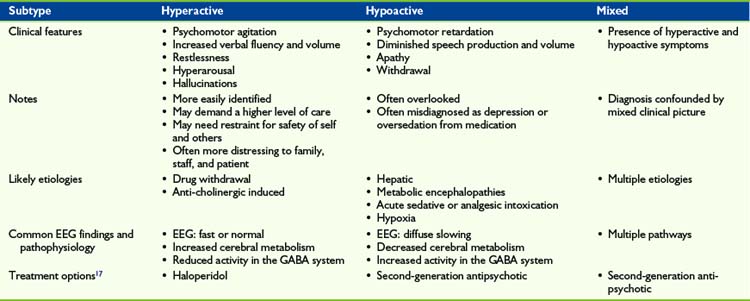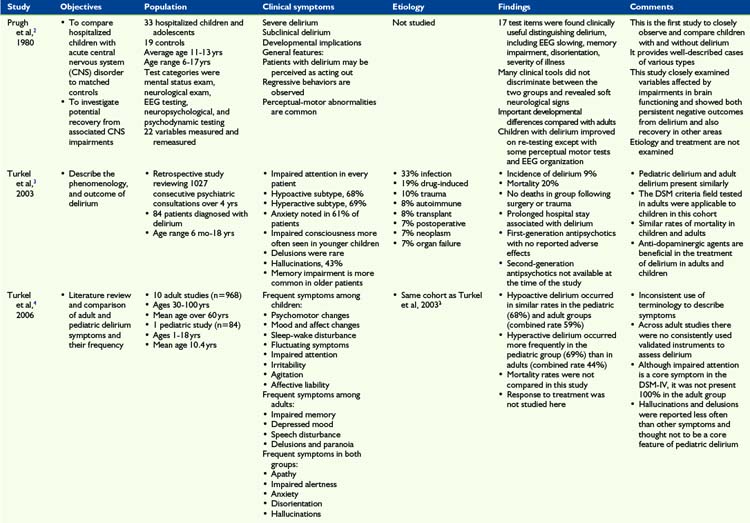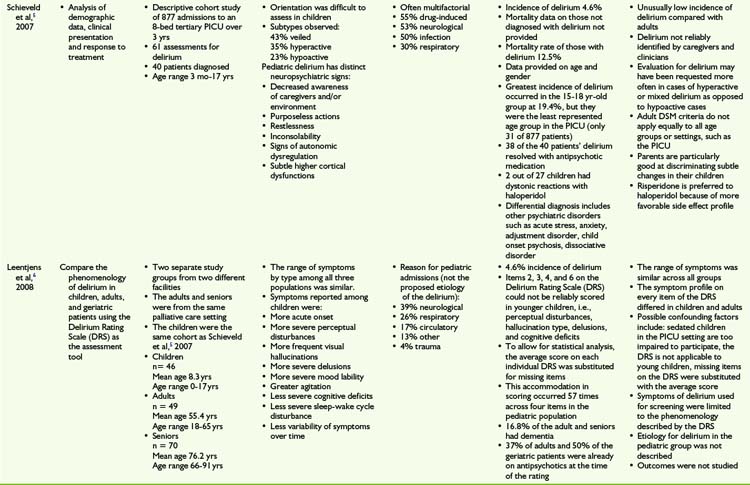28 Delirium
Pediatric delirium is an under-recognized and often reversible complication of critical illness that is considered a medical emergency demanding immediate management.1 New research on the clinical presentation of pediatric delirium and age-appropriate assessment tools for prompt identification have highlighted some of the differences between the adult and pediatric populations.2–6 In the context of palliative care, delirium is one of many crises, including pain, anxiety, and dyspnea, which require a thorough and collaboratively developed plan of care.7
In the adult palliative care setting, delirium has been carefully studied and identified as a sign of impending death.8,9 Among adult patients who are terminally ill, delirium is the most common neuropsychiatric disorder with a prevalence estimated as high as 85%.10 In a palliative care setting, researchers11 identified 42% of the patients with a diagnosis of delirium at the time of hospital admission, and an additional 45% who developed delirium during their hospital stay. These data suggest that delirium occurs in the majority of patients nearing the end of life and that improved methods of diagnosis and management are warranted for this highly distressing and often reversible condition. Therefore, in all critically ill patients of every age, mental status should be carefully evaluated in addition to conventional monitoring of pulse, temperature, respiratory rate, blood pressure, and pain.12
The study of delirium is at the confluence of a number of clinical disciplines including anesthesiology, critical care medicine, pediatrics, geriatrics, oncology, pain medicine, palliative medicine, neurology, psychiatry, psychology, nursing, pharmacy, and bioethics. Across these domains, there has been a recent groundswell of interest in delirium,13 and specifically pediatric delirium, after a long period of neglect between 1980 and 2003.2,3 Advances in medical care that prolong life place critically ill patients at greater risk for delirium. In addition, awareness of potential cognitive and psychological sequelae of delirium has led to efforts directed at early recognition and treatment. Goals of palliative and general clinical care target delirium as a symptom that necessitates immediate care.14
The aim of this chapter is to provide an overview of pediatric delirium and its clinical relevance in the palliative care setting. An additional goal includes underscoring the interdisciplinary nature of delirium. Any clinician or caregiver, including respiratory therapist, nurse, doctor, pharmacist, and parent, has the opportunity to screen patients for delirium. Delirium has many causes, occurs in both simple and complex clinical situations and should be suspected in all circumstances when mental status is altered. One long-term study has shown that nurse-directed delirium prevention and management programs, involving multidisciplinary education and collaboration, have led to a decrease in delirium and clinician workload.15 Every member of the treatment team serves as a resource in the prevention, recognition, and management of delirium.
Definition
According to the Diagnostic and Statistical Manual16 the core features of delirium include a disturbance of consciousness, change in cognition, and perceptual disturbance that develops over a short period, usually hours to days, and fluctuates over time (Box 28-1). Delirium has been associated with rates of morbidity and mortality that surpass those of all other psychiatric diagnoses.17 Across clinical disciplines and countries, there are many ambiguities in the terminology used to describe delirium.18 Such terms as acute brain failure, encephalopathy, acute confusional state, and intensive care unit (ICU) psychosis have been widely employed, and the critical care literature has now conformed to the recommendations of the American Psychiatric Association, and other experts, that the term delirium be used uniformly to describe this syndrome of brain dysfunction.19 The need for shared terminology reflects the challenges clinicians face in diagnosing delirium across clinical settings and age groups.
BOX 28-1 DSM-IV-TR Diagnostic Criteria for Delirium
Adapted from the American Psychiatric Association: Diagnostic and Statistical Manual of Mental Disorders, 4th edition revised, (DSM-IV-TR).Washington, DC, American Psychiatric Press, 2000.
Clinical presentation
Although the clinical presentation of delirium in children and adolescents is considered to be similar to that of adults, there are observed differences in the type and frequency of symptoms across various age groups.4,5,6 Clinician-observed features of pediatric delirium varied across several studies. Pediatric patients are described as having more frequent fluctuation in symptoms, greater affective lability, impaired attention, and disturbances in their sleep-wake cycle.4 By contrast6 a study described pediatric patients as having lower rates of sleep disturbance, fewer cognitive deficits, and lower levels of symptom fluctuation.
With regard to psychotic symptoms, authors have described both lower and higher prevalence of perceptual disturbances and delusions among children compared to adults.4,6 Some4 have suggested that delusions and hallucinations may not be core symptoms of pediatric delirium. Alternatively, a study of pediatric patients emerging from anesthesia reported that younger children had higher rates of hallucinations and other perceptual disturbances, compared with older children.20 These differences may reflect variations in brain function across the age span, developmental immaturity in children, functional decline in old age, and differences in the expression of distress during hospitalization.21 The variance in observed clinical features is wide and may result from the fluctuating nature of the illness, the subjective nature of clinical assessment, lack of age-appropriate screening tools, and the various causes of delirium.
Subtypes of Delirium
Three motoric subtypes of delirium–hypoactive, hyperactive, and mixed–have been well described in the adult literature.22 Delirium is also categorized on the basis of symptom severity, with terms such as pre-delirium, sub-syndromal, veiled, and full-blown used to designate differences in presentation.23 These additional terms reflect growing research into the phenomenology of delirium. Although few studies have focused on categorizing delirium temporally or by severity, the practical finding from this work is that delirium may be detectable earlier in its course with vigilant screening. In this chapter, a discussion of motoric subtypes is reviewed with vignettes (Table 28-1).
Mixed delirium describes patients who fluctuate between hyperactive and hypoactive states.22,25 These critically ill patients present with an array of symptoms, in the context of possible pain, anxiety, and nausea, making it difficult to recognize delirium and identify the cause.
Prevalence and Epidemiology
Among adult studies, delirium has been reported in 15% to 18% of patients on acute medical and surgical wards, with higher rates in specific populations.17 One of the largest retrospective pediatric studies on delirium,3 reported a 9% prevalence of delirium in a sample of 1027 patients referred for psychiatric consultation (Table 28-2). Another study5 reported a lower prevalence of 4.6% in a pediatric sample of 877 critical care patients.
Among pediatric patients, age as a risk factor for delirium is not well known. The study of 1027 patients3 identified 84 patients with delirium ages 6 months to 18 years and there was no significant difference in mean and median age based on the cause of delirium. The study did not assess whether age itself was risk factor for delirium. According to the study5 that presented data stratified by age, the greatest incidence of delirium occurred among the oldest children (15 to 18 years), but these data were not analyzed for statistical significance. Conversely, another study26 found a negative correlation between age and delirium among post-anesthesia patients suffering with emergence delirium.
Although studies to assess the prevalence of delirium in children receiving end-of-life care have not yet been undertaken, data from adult studies suggest potentially much higher rates in this population. For example, immediately before death, delirium rates of 68% to 88% have been reported in adult oncology patients.11,27 More specifically, according to a review8 hypoactive delirium, which is easily overlooked, has been reported as high as 40% to 78% in adult palliative care patients.11,28,29
Attempts to quantify the prevalence of delirium by subtype among adults have resulted in a range of findings. For example, a study30 reported hypoactive delirium (43.5%) occurring considerably more often than “purely” hyperactive delirium (1.6%), and mixed delirium was the most frequently observed subtype (54.1%). The low number of cases with hyperactive delirium in this cohort is unusual when compared with other studies that report rates of hyperactive delirium ranging from 15% to 80%.22,31 On the other hand, the high number of cases in the cohort30 of 375 elderly diagnosed with hypoactive delirium suggests that careful screening may accurately identify more subtle presentations of delirium. The only comparison4 of the prevalence of hyperactive and hypoactive states in adults to children found across three adult studies there was an average of 59% hypoactive delirium, similar to a pediatric prevalence of 69%. Agitation was noted in the adult studies at a combined rate of 44%, which was significantly lower than the pediatric rate of hyperactive delirium of 68%.
In adult palliative care literature, the rates of hypoactive delirium are as high as 86%, mean prevalence 48% in one meta-analysis, while rates of hyperactive delirium vary between 13% to 46% of patients.29,32 Figures for the prevalence of delirium by subtype in the pediatric palliative care setting are not known.
Despite the varied estimates on prevalence, numerous studies suggest that the motoric subtypes of delirium differ beyond the degree of psychomotor activity. Studies show variation between hypoactive, hyperactive, and mixed delirium with regard to other non-motoric features of delirium,33 etiology and pathophysiology,34 ease of detection and assessment, response to treatment,24 and outcome.35 Notably, clinician observations of patient psychomotor disturbance were less reliable when compared with data from electronic motion detectors.36 Because recognition of delirium continues to be challenging and machine-assisted assessment is helpful, there is the potential that future technological innovations may enhance clinician assessment. For example, similar to the use of heart monitors in the ICU, motion detection may be used to help alert clinicians to the presence of delirium among high-risk groups (see Table 28-2).
Etiology
Causes and risk factors for delirium are often multifaceted and include vascular, infectious, neoplastic, degenerative, organ failure, toxic, deficiencies including vitamin, congenital, central nervous system pathologic, traumatic, endocrinological, metabolic, dehydration, heavy metal, and anoxic phenomena.17 Medication-related etiologies, as a result of toxic effects or withdrawal reactions, are also common. As with adults, certain classes of medications such as steroids, opiates, benzodiazepines, and anticholinergic agents are frequent precipitants.
In the palliative care setting, delirium often results from aggressive treatment of pain and suffering, which can lead to drug-induced change in mental status.9 A study of 40 critically ill children5 found that the most frequent causes of delirium in decreasing order included a change in analgosedative medication, neurological disorders, infections, and respiratory disorders. Often there were multiple causes for delirium. Infection was twice as often the precipitating factor compared with drug induced-delirium in one report.4 A thorough diagnostic workup to identify the cause is the standard of care37; however, in the palliative care setting where the goal of care is to decrease pain and suffering, this approach is often modified.
Pathogenesis
Delirium is a neuropsychiatric disorder involving global en-cephalopathy dysfunction caused by multiple impaired neural pathways and physiologic compromises. The neurotransmitters that have been implicated in the pathophysiology of delirium include acetylcholine, dopamine, glutamine, gamma aminobutyric acid (GABA), and serotonin.34 Dopamine is thought to modulate mood and cognitive function, and in excess can lead to psychotic disorders. Similarly, acute alterations in dopamine levels may contribute to the characteristic symptoms of delirium. Antipsychotic medications that inhibit the dopamine pathway are effective in treating delirium.38 Alteration of GABA, an inhibitory neurotransmitter, may also cause changes in cerebral functioning, possibly by affecting sleep patterns. In the critical and palliative care setting medications such as benzodiazepines and propofol, which directly affect GABA receptors, are frequently used and have been found to contribute to the development of delirium in the ICU setting.39 Likewise, acetylcholine deficiency is associated with delirium and the use of anticholinergic drugs has been found to precipitate and worsen symptoms of delirium.40 These neurotransmitter perturbations are thought to cause neuronal membrane hyperpolarization, thus spreading neuronal depression, which is seen on EEG as a diffuse slowing.41
Other insults to cerebral functioning such as inflammation, hypoxia, metabolic encephalopathies, and drugs or toxins, are implicated in the development of delirium. Inflammation, caused by infection, surgery or other tissue injury, heightens blood-brain barrier permeability leading to translocation of inflammatory mediators, such as cytokines and chemokines, into the CNS, causing encephalopathy dysfunction.42 Cytokines such as interleukin (IL)-1, IL-2, interferon (IFN) and tumor necrosis factor (TNF) can affect neuronal pathways by inhibiting acetylcholine, leading to agitation, perceptual disturbances, seizures, and delirium.43 There are reports of chemokine elevations in patients with delirium, and one study found IL-6 increase in children with influenza that developed delirium.44 Inability to meet oxygen needs, either because of increased demand or decreased delivery, contributes to development of delirium because of disruption of ionic gradients, neurotransmitter homeostasis, and neurotoxic byproduct elimination. The compromise of oxygen metabolism can be due to hypoglycemia, hyper- or hypothermia, and vitamin or amino acid deficiencies. Impaired oxygen metabolism leads to reduced neurotransmitter synthesis, causing a deregulation of sleep-wake cycle, behavior and mood, and psychomotor activity, all of which are clinical manifestations of delirium.38,45






